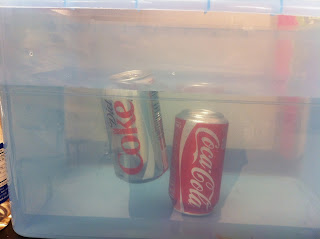Anybody else think of George McFly hitting on his future wife in Back to the Future when you hear the word density?
 Ha! Ok, maybe it's just me. I digress.
...Anyway...
Today in our mass, volume, and density unit we discussed the concept of density.
Density is how tightly packed together matter is inside something.
I performed two experiments that were great displays of density--and cool experiments you can try at home also if you're feeling a little curious!
Experiment #1: Sink or Float?
I started this experiment with one unopened can of diet coke, and one unopened can of regular coke. I got two
Ha! Ok, maybe it's just me. I digress.
...Anyway...
Today in our mass, volume, and density unit we discussed the concept of density.
Density is how tightly packed together matter is inside something.
I performed two experiments that were great displays of density--and cool experiments you can try at home also if you're feeling a little curious!
Experiment #1: Sink or Float?
I started this experiment with one unopened can of diet coke, and one unopened can of regular coke. I got two assistants students to look at each can and tell me how many fluid ounces were in each can. Of course, both cans had 12 fl. oz., so we agreed as a class that both cans had the same amount of liquid inside them.
Next, I told the students that I was going to drop the cans inside a big bucket full of water. They made predictions about what would happen when both cans were dropped into the bucket.
Last, I dropped both cans into the bucket and........
VOILA! The regular Coke sinks, and the Diet Coke floats! We then inspected the nutrition facts of both cans to determine why this was.
Coke has 29 g of sugar, while Diet Coke has 0 g of sugar! We determined this sugar made the Coke more dense, and caused it to sink in the tub of water instead of the Diet Coke. :) Cool, right?
Experiment #2: Layers of Liquids
This experiment began with a glass vase with a little bit of water inside. I then added various liquids to the glass to show the students which liquids were more dense than others. (The trick here is to pour the liquids so that they touch the side of the glass and slide down towards the water. If you pour the liquid in the middle of the water, they will mix and the experiment won't work!)
Liquids inside the glass: water (with red food coloring added), Palmolive detergent, AJAX detergent, corn syrup, and lamp oil
Here is the final result!
After the liquids were added, we had a discussion of which liquid was the most dense and least dense. The lamp oil was the least dense of all the liquids, and we discussed how oil and water never mix together. Then something MIRACULOUS happened. One of my students said this:
"Mrs. Newberry, it's just like the BP oil spill that happened in the ocean. The oil was just sitting on top of the water."
WOW! What an amazing connection to history! Of course, I had to take a little detour on my density lesson and take advantage of that teachable moment to share some information about the oil spill with my students. We read some facts in this book:
I love moments like that in the classroom! Today was a great day in Science class!
















